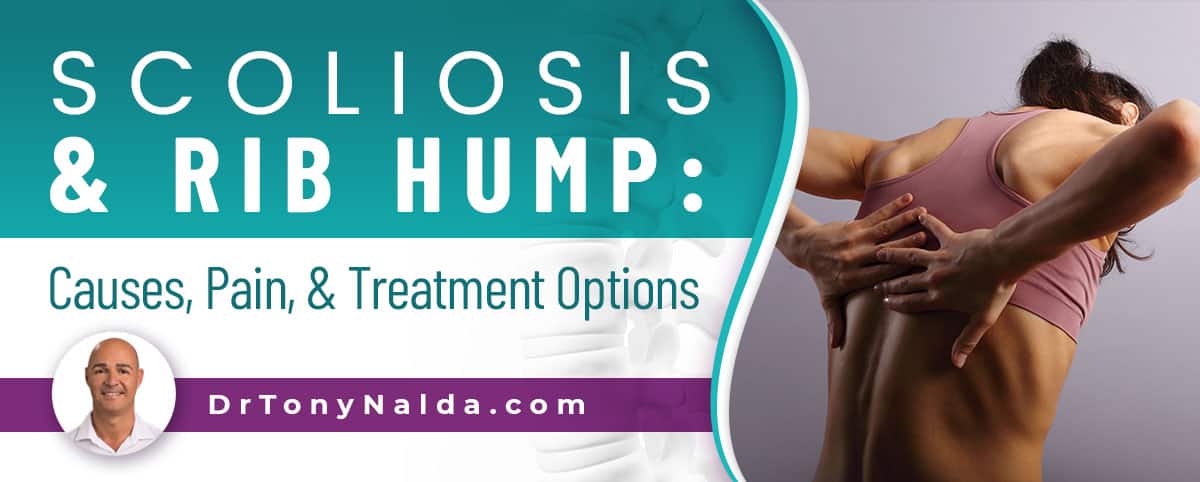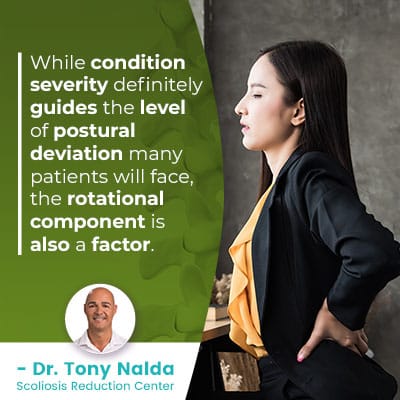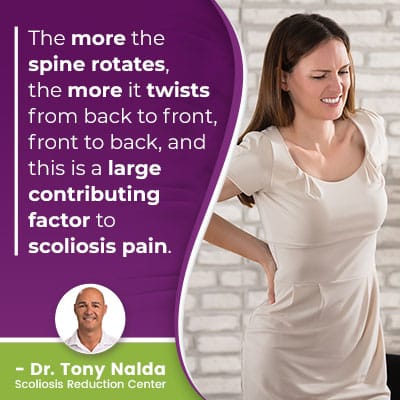Scoliosis & Rib Hump: Causes, Pain, & Treatment Options

Scoliosis can affect the body in a myriad of ways, from changes to posture, body symmetry, gait, balance, and coordination to back and radicular pain. Visual symptoms related to postural deviation also have emotional effects. Continue reading for a better understanding of how scoliosis can cause the development of a rib arch.
In the condition’s most-prevalent form, adolescent idiopathic scoliosis, the main scoliosis symptom is postural deviation, and this is due to the condition’s uneven forces. A rib hump is a common condition indicator as the unnatural curve pulls on the rib cage and disrupts its position.
Let’s start our discussion of rib humps caused by scoliosis by first defining the condition itself.
What is Scoliosis?
Scoliosis is the development of an unnatural spinal curve, with rotation and a minimum Cobb angle of 10 degrees.
The rotational component is what makes scoliosis a 3-dimensional condition as the spine doesn’t just bend unnaturally to the side but also twists from front to back, back to front.
The Cobb angle is a measurement taken during an X-ray that tells me how far out of alignment a scoliotic spine is.
A patient’s Cobb angle is measured by drawing lines from the tops and bottoms of the curve’s most-tilted vertebrae (bones of the spine) at the apex of the curve, and the intersecting angle is measured in degrees and classifies conditions in terms of severity:
- Mild scoliosis: Cobb angle measurement of between 10 and 25 degrees
- Moderate scoliosis: Cobb angle measurement of between 25 and 40 degrees
- Severe scoliosis: Cobb angle measurement of 40+ degrees
- Very-severe scoliosis: Cobb angle measurement of 80+ degrees
So as you can see from the wide range of severity, scoliosis is a highly-variable condition, which is why symptoms one patient experiences aren’t indicative of what everyone will face.
In addition to different severity levels, there are multiple condition types with their own causes, different sections of the spine that can be affected, and different curvature types and patterns.
Another key condition characteristic of scoliosis, and one that makes it challenging to treat, is progression.
Scoliosis is Progressive
One of the reasons that scoliosis is so often deemed a complex condition to treat, and live with, is its progressive nature.
Being progressive means it’s in the nature of the condition to worsen over time, particularly if left untreated or not treated proactively. So, where scoliosis is at the time of diagnosis is not indicative of where it will stay: only proactive treatment can counteract that.
Although scoliosis isn’t curable, it can't kill you and it is highly treatable. As scoliosis progresses, this means the unnatural spinal curve is increasing in size, and so too are the uneven forces being introduced to the body.
While we don’t know what causes the most prevalent condition type to develop initially (idiopathic scoliosis), we do know how to treat it effectively, and we do understand what causes it to progress: growth and development.
So young patients who have not yet reached skeletal maturity are at risk for rapid-phase progression, and as a condition gets worse, its symptoms tend to become increasingly noticeable, including postural deviation like the development of a rib arch.
Scoliosis can indeed lead to a rib hump, which can cause the appearance of the stomach sticking out in some cases due to the spinal curvature affecting the alignment of the ribs and torso.
Postural Symptoms of Scoliosis
As mentioned, scoliosis introduces a lot of uneven forces to the body, which is why one of its main effects is postural deviation caused by a disruption to the body’s overall symmetry.
In the condition’s most-prevalent form, adolescent idiopathic scoliosis, its earliest indicators are often uneven shoulders and hips, and additional forms of postural deviation caused by scoliosis can include:
- The head appears uncentered over the body
- Eye line appears tilted
- The development of a rib arch
- An uneven waistline
- Uneven hips with one sitting higher than the other, or one appearing flatter, or more rounded than the other
- Arms and legs that appear to hang at different lengths
In addition, clothing can become ill-fitting, and changes to gait, balance, and coordination are also common.
So now that we’ve discussed some important condition characteristics, including diagnosis, severity, and symptoms, as the spine is attached to the rib cage, let’s address the connection between scoliosis & left rib hump and right rib hump scoliosis.
Scoliosis Rib Hump
 I’d first like to say that the term rib hump has been replaced by rib arch to help remove the negative stigma of spinal conditions being thought of as a type of deformity, so now when the term rib arch is used, we are strictly referring to the condition’s effect on the rib cage.
I’d first like to say that the term rib hump has been replaced by rib arch to help remove the negative stigma of spinal conditions being thought of as a type of deformity, so now when the term rib arch is used, we are strictly referring to the condition’s effect on the rib cage.
A rib arch is a primary indicator of scoliosis and its progression; the unnatural curve pulls on the rib cage, causing one side to protrude more than the other, and this is most common in cases of thoracic scoliosis .
There are three main spinal sections: cervical (neck), thoracic (middle/upper back), and lumbar spine (lower back).
A rib arch is the most common with thoracic spine scoliosis as this means the unnatural curve is in the middle/upper back: closest to the rib cage.
While condition severity definitely guides the level of postural deviation many patients will face, the rotational component is also a factor.
So it’s not just how large a scoliotic curve is, but also how much it twists that determines the presence and size of a scoliosis rib arch.
Let’s now address scoliosis ribs arch causes in more detail.
Rib Hump Causes
While many assume the spinal canal is located in the middle of the spine, it’s actually located near the back of the spine, through which the spinal cord passes.
Because the spinal cord is so flexible, it can traverse the spine’s natural curves. If you look at a healthy spine from the front or back, it will appear straight, but if you look at it from the sides, it will take on a soft ‘S’ shape, and this is due to natural and healthy spinal curves that make it stronger, more flexible, and better able to absorb stress.
In a healthy spine without adverse nerve tension, the cord can stretch and flex to work with the body’s movement; in fact, the spinal cord is said to be able to elongate by 5 to 7 centimeters when fully stretched.
When nerve tension is present due to the cord being exposed to uneven pressure from the unnatural curve, it effectively results in a shorter spinal cord, making it harder for the spinal cord to stretch as far as it should; the cord then takes the shortest path possible to span the length of the spine as needed, and this pulls the spinal cord ever tighter, increasing adverse spinal tension.
When a tight cord is being pulled excessively and becomes tighter, the spinal cord responds by rotating unnaturally in order to avoid the adverse spinal tension and find its shortest path.
Because the spine runs through the spinal canal near the back of the spine, rotation helps give the spinal cord a shorter path to traverse. It’s the nerve and tension-driven rotation that can cause the development of a rib arch, thought by some to be the initial cause behind the development of idiopathic scoliosis.
With adolescent idiopathic scoliosis, the idiopathic designation means we don’t know why it developed.
Part of screening for indicators of scoliosis involves looking for signs of postural asymmetries and the angle of trunk rotation (ATR).
When it comes to scoliosis pain in general and rib arch pain specifically, there are different factors that feed into how painful a condition is.
Thoracic scoliosis can lead to a right rib hump and biomechanical rib cage dysfunction, which may cause chest pain and discomfort, and although it generally does not pose a life-threatening risk, effective treatment options which are essential for managing symptoms and addressing causes of protruding ribs and lumbar spine misalignment.
Rib Hump Pain
Not only does condition severity factor into how painful a person’s scoliosis is, it’s also the angle of trunk rotation.
The more the spine rotates, the more it twists from back to front, front to back, and this is a large contributing factor to scoliosis pain.
 In addition, scoliosis doesn’t become a compressive condition until adulthood, when skeletal maturity has been reached.
In addition, scoliosis doesn’t become a compressive condition until adulthood, when skeletal maturity has been reached.
In young patients who are still growing, their spines are experiencing a constant lengthening motion, and this counteracts the compressive force of the unnatural spinal curve, and its compression of the spine and its surrounding muscles and nerves that cause the majority of condition-related pain.
However, even adolescents not facing compression report dealing with muscle pain, and this is because it’s not just the spine that’s in charge of maintaining its natural curves and alignment but also its surrounding muscles.
Muscles surrounding the spine struggle to support it as they are pulled in different directions because of the uneven forces of the condition; as a result, they can become tight, sore, and strained.
So when it comes to scoliosis rib arch pain due to compression, it’s more likely to be painful for adults, although when severe, even in adolescents, pain can be present, particularly in the form of muscle pain.
Treatment Options for a Scoliosis Rib Hump
When it comes to treating a rib arch, it’s important to understand the distinction between treating a symptom of a condition or the condition itself: the underlying cause of its symptoms.
Here at the Scoliosis Reduction Center, I use a proactive conservative chiropractic-centered treatment approach to treat the condition itself.
By combining multiple condition-specific treatment disciplines like chiropractic care, in-office therapy, corrective bracing, and custom-prescribed home exercises, I can work towards achieving the following things:
- Impacting the condition’s underlying structural nature
- Increasing core strength, so the spine is optimally supported by its surrounding muscles
- Using corrective bracing to augment other forms of corrective treatment
- Prescribing custom exercises to help establish a home-rehabilitation program for further stabilizing the spine and sustainable long-term results
Addressing the underlying cause of symptoms, like the rib arch, which are the condition’s uneven forces and postural deviation, and working towards a curvature reduction, as much of the spine’s healthy curves as possible are being restored.
Restoring the spine’s healthy curves also means there is less uneven pressure on the spine and its surrounding muscles and nerves, so it helps with pain as related compression is reduced alongside the curvature size.
Conclusion
Scoliosis is a structural spinal condition that involves the development of an unnatural sideways spinal curve with rotation.
Scoliosis, characterized by uneven hips, can sometimes result in discomfort such as scoliosis chest pain. Fortunately, there are treatment options for teens and adults available, including scoliosis stretches, to alleviate these scoliosis side effects and reduce the risk of severe complications, as it's extremely rare to die from scoliosis in modern medical practice.
As the condition introduces uneven forces to the body, it disrupts its overall symmetry and can affect posture in different ways: uneven shoulders, hips, and the development of a rib arch. It can also impact sleep and in some patients' surgery might be recommended.
A rib arch is a symptom of scoliosis as the unnatural spinal curve pulls on the rib cage, disrupting its position and making one side protrude more than the other.
Rib arches are more likely to be painful for adults who have reached skeletal maturity when the condition becomes compressive, and for children and adolescents, although when severe, the arch can cause discomfort, related muscle pain is more likely to be an issue.
When it comes to the best treatment option for a rib arch, we’re talking about proactive treatment that addresses its underlying cause: the structural nature of the condition itself.
Dr. Tony Nalda
DOCTOR OF CHIROPRACTIC
After receiving an undergraduate degree in psychology and his Doctorate of Chiropractic from Life University, Dr. Nalda settled in Celebration, Florida and proceeded to build one of Central Florida’s most successful chiropractic clinics.
His experience with patients suffering from scoliosis, and the confusion and frustration they faced, led him to seek a specialty in scoliosis care. In 2006 he completed his Intensive Care Certification from CLEAR Institute, a leading scoliosis educational and certification center.
About Dr. Tony Nalda
 Ready to explore scoliosis treatment? Contact Us Now
Ready to explore scoliosis treatment? Contact Us Now





